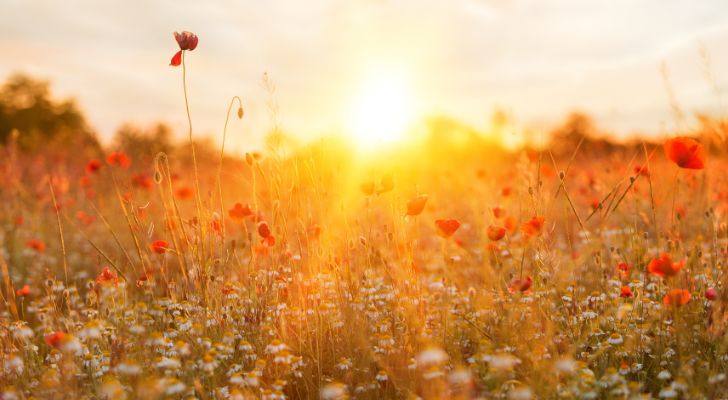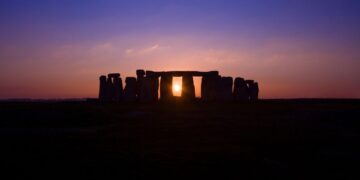Summer is many people’s favorite season, and it usually brings beautiful sunny weather for everyone to enjoy!
No matter how old you are, there are many exciting opportunities to look forward to during this season.
If you want to discover some sizzling hot facts about summer, you’re in the right place! Keep reading to get clued up on everything to do with summertime.
Summer happens at different times around the world.

Summer in the Northern Hemisphere falls between June and September. The summer solstice, the longest day of the year, defines the beginning of summer. The summer solstice is normally June 21 or 22.
It ends when the fall equinox happens, normally on September 22 or 23. The fall equinox is the day when both day and night are equal.
As the Southern Hemisphere experiences the opposite seasons to the Northern Hemisphere, the summer there runs from December 22 or 23 to March 20 or 21.
The word “summer” has been around for centuries.

The word “summer” was first recorded before the year 900. It comes from the Old English word sumor, which literally means the season of summer.
It is also linked to the German word sommer and the Sanskrit word sama, both of which mean “year.”
It was used as an adjective (a describing word) from around 1300. People began using phrases like “summer camp” and “summer resort” during the 1800s.
Millions of children enjoy a long break from school during summer.

In dozens of countries, children take between two weeks and three and half months off school.
In the United States, students finish school in May or June and resume in August or September. One reason for this long break is so students and teachers can rest their brains.
It also helps to prevent heat exhaustion during these warm months in summer. This is especially important for younger children because they are still developing.
The Eiffel Tower gets taller in summer.

When the weather is warmer, metal objects get bigger. This is known as thermal expansion, which means that the heat causes materials like metal to expand.
Because of this, the Eiffel Tower in Paris grows during the summer. It can grow up to 15 cm (5.9 inches) taller!
This famous tower also tilts away from the Sun when the weather is warmer. The Sun only shines on one side of the Eiffel Tower, which means it is not balanced on all four sides. As a result, it also leans up to 15 centimeters in one direction!
Emergency hospital services are busier over the summer.

There is never a good time to need hospital treatment, but the summertime can be particularly busy in the emergency room. Medical experts call this the “July phenomenon.”
In July, new trainees arrive to begin working at hospitals and other medical centers. These new staff have just finished training and need more practical experience working in hospitals.
This can mean insufficient fully-trained staff are available to deal with emergency medical problems. As a result, complications and problems may increase.
The Sun doesn’t set for weeks in some Nordic countries.

In the most northern parts of the world, the Sun doesn’t set for weeks in the summer. This includes some northern parts of Norway, such as Svalbard, where you will see the Sun 24 hours a day between April 20 and August 22.
This amazing natural phenomenon is known as the “midnight sun.” It happens because the Earth’s rotation tilts, and the North Pole faces the Sun.
The midnight sun gives the sky a beautiful red and yellow color. Because the Sun doesn’t set, it is light all the time. It can feel like one long day that lasts for weeks!
The most popular birthday is in summer.

Birthdays in early September are the most common. In the United States, September 9 is the most popular birthday. The second most popular birthday is September 19, and September 12 is not far behind.
In contrast, the least popular birthdays happen during December and January, with Christmas Day (December 25) and New Year’s Day (January 1) being the most rare.
However, some dates earlier in the summer have also proven unpopular. July 4 is one of the most uncommon birthdays.
The world’s heaviest scoop of ice cream was unveiled during a summer festival.

In June 2014, a scoop of strawberry ice cream that measured 5.5 by 6.2 feet (168 by 188 centimeters) broke the world record for the heaviest scoop of ice cream.
It weighed more than 3,000 pounds (1365 kg) and was sculpted from 733 containers of ice cream.
The record-breaking scoop was made to celebrate the 100th anniversary of Kemps, a dairy company based in Minnesota, USA.
They unveiled it at the Cedarburg Strawberry Festival and gave everybody a scoop of this famous ice cream!
The hottest days of summer are called the “dog days.”

Since the era of the Roman Empire (27 BC – 476 AD), people have used the phrase “dog days of summer” to describe the hottest days of the year.
These dates are between July 3 and August 11. They are linked to the star Sirius, also known as the Dog Star. Sirius is the brightest star in the sky, rising and falling twenty days before and after the “dog days.”
The Olympic Games happen during summer.

The world-famous Olympic Games are held every four years. They began in 1896 in Athens, Greece, and have continued ever since.
Known as the “Summer Olympic Games” or simply “Summer Olympics,” this international event usually happens during July and August. It brings together competitors from different sports to compete in various sports for gold, silver, and bronze medals.
The Winter Olympic Games are also hosted every four years, normally in February.
There are lots of songs about summer.

Famous singers and songwriters have loved the Sun for decades. You can probably think of a song about the summer!
For example, the Beatles wrote about summer in their 1969 hit song “Here Comes the Sun.” Olivia Newton-John sang about “Summer Nights” in the 1978 movie “Grease.”
And in 2019, Megan Thee Stallion looked forward to a “Hot Girl Summer.”
How many other summer songs can you think of?
Summer is a girl’s name.

Summer gained popularity as a baby name in the 1950s, 60s, and 70s. Some celebrities have this name, such as sports commentator Summer Sanders and R&B singer Summer Walker.
The name was first used in the United Kingdom. You are probably not surprised to find out that this name literally means “summer!”
It reflects the beauty of summertime and the light and warmth that comes with this season.
There is a famous piece of classical music that is all about summer.

Italian composer Antonio Vivaldi was inspired by summer and the other seasons when he wrote his famous piece “ The Four Seasons” in 1725.
The Four Seasons is made up of four parts. The second in this collection is called “Summer.”
Antonio Vivaldi was trying to tell the story of a hot summer day with thunderstorms and showers. A shepherd and his sheep are disturbed as lightning, hail, and rain begins.
It snowed in the United Kingdom in the summer of 1975.

It is not common for people in the United Kingdom to experience snow in the summer. However, in June 1975, snowfall hit many parts of the country, including the capital of London.
Some cricket matches had to be canceled because of the snow, disrupting this popular summer sport.
It was the first time there had been so much snow in the United Kingdom during summer since 1888 – almost one hundred years earlier!
The Secret Solstice happens every summer in Iceland.

Iceland experiences the “midnight sun,” which happens when the Sun does not set for several weeks during summer.
The Secret Solstice festival takes place in June during the summer solstice, the longest day of the year.
This unique festival allows people to experience music and culture during a special time of the year. It is the only place where party-goers can rave in a glacier and watch musicians in a 5,000-year-old lava tunnel!
Shakespeare talks about summer in his 18th sonnet.

The famous poet William Shakespeare wrote 154 sonnets (poems with fourteen lines). One of his best-known works was his 18th sonnet, “Shall I compare thee to a summer’s day?”
In this sonnet, published in 1609, William Shakespeare compares a young person to a beautiful summer’s day. He writes that the young person is even more beautiful than the summer.
The Sun may sometimes be too hot, or clouds may appear, Shakespeare writes in this poem. But a young person, on the other hand, does not have these problems – making them even better than the summer.
While it is one of the most famous poems, this is obviously not the only one about summer. Another popular piece is Thomas Moore’s “The Last Rose of Summer,” published in 1813.
Watermelon is one of the most hydrating summer snacks.

Watermelon is 92% water, making it an excellent choice of snack in the summer months.
When the weather is warm, your body tries to keep cool by sweating. This causes you to lose water and salts, which need to be replaced.
It should come as no surprise that watermelons are among the most popular fruits during summer.
Watermelons are the favorite melon of people in the United States. Every year, on average, each American eats more than 14 pounds (6.4 kilograms) of watermelon!
Japan hosts a lantern festival every summer.

Japan is full of lanterns during July and August as people celebrate the Tanabata Festival. The festival has its origins in a tale of two lovers, Orihime and Hikiboshi, who could only meet on July 7.
Orihime and Hikiboshiare are represented by the stars Vega and Altair, which explains why the Tanabata Festival is also known as the “Star Festival.”
The festival is celebrated all over the country. Parades happen in cities like Noshiro, where massive lanterns are carried through the streets. Some lanterns are more than 78 feet (24 meters) tall!
Thousands of flowers bloom during this season.

There is a reason why flowers often remind us of the summer months. Morning glories, marigolds, and sunflowers are just a few of the beautiful flowers that bloom at this time of year.
One of the flowers that blooms during summer is called Sneezeweed! This funny name has been given to a red and yellow flower resembling a daisy. They need lots of sunshine and will attract butterflies in your garden.
More than half of British people say summer is their favorite season.

When 2,000 adults in Britain were asked about their favorite season, more than half chose summer.
Some things they loved about summertime included spending time in their gardens and enjoying the smell of freshly cut grass.
Others said they liked the warmer weather, so they didn’t have to spend money turning the heating on!
Around a third of people said that whatever they do in summer, they look forward to spending quality time with the people they love.
People flock to New York’s streets to see Manhattanhenge in the summer.

New York City is built in neat blocks, and during the summer, you can see the sunset line up perfectly through the grid-like streets.
This beautiful scene is known as “Manhattanhenge,” a play on words based on the famous landmark Stonehenge in England.
If you didn’t know, the large rocks of Stonehenge also line up with the sunrise during the summer solstice, letting everyone know that the season is changing.
There are days in May and July when you can see Manhattanhenge in all its glory!
Who would have thought there were so many sizzling facts about the summer?
This special season can bring many fun and unique experiences, no matter which part of the world you are in.
Next time you’re enjoying a day at the beach or a sunny walk, you might remember one of these interesting facts!


















